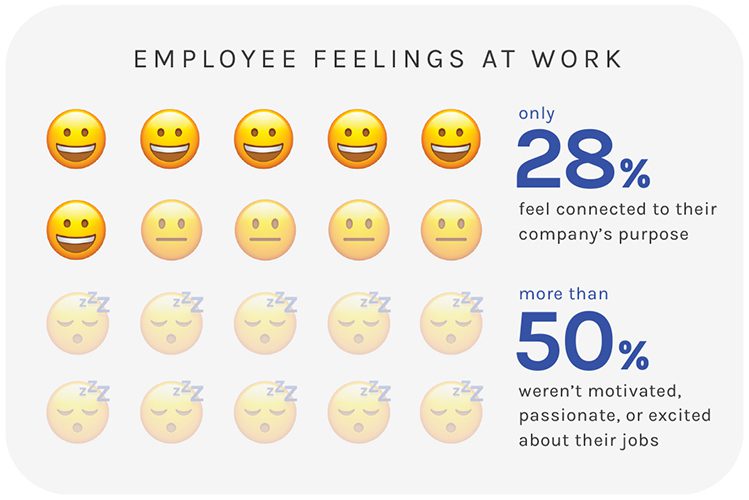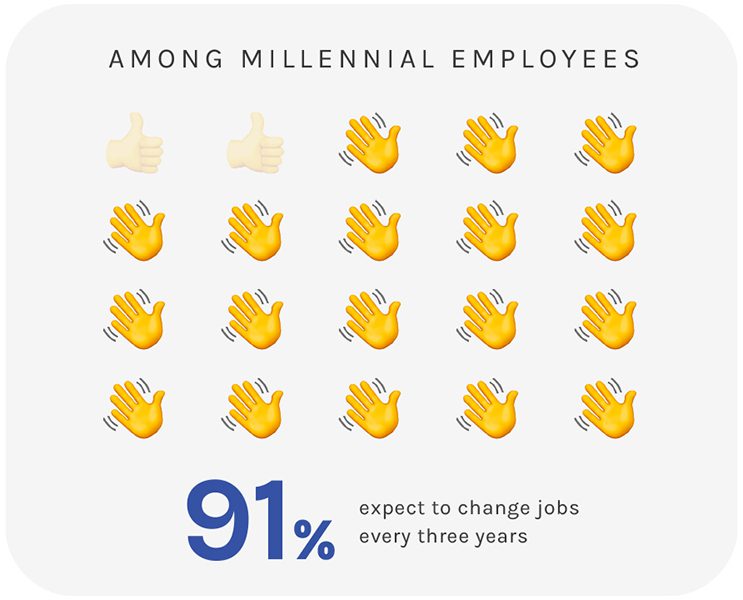Drink the Kool-Aid, but don’t chug it: a complete skeptic’s guide to writing more authentic company mission statements.


Over the years, the “drinking the KOOL-AID” expression has become a shorthand for cultish conformity. It’s a reference to the 1978 Jonestown tragedy in which people lost their lives after buying into a cult mentality.
Skepticism, the enemy of blind adherence, is a handy defense mechanism.
It probably could have saved lives in Jonestown. And it’s an appropriate filter for thinking about how to write a company mission statement. So here’s how to articulate an authentic mission and vision without leading an army of the blind directly off a large cliff.
Today’s millennial workforce was taught critical thinking before learning the alphabet, and they will reflexively scrutinize everything put in front of them. They were brought up to question authority.
Regarding their feelings at work, a survey from Price Waterhouse company Strategy &, found that only 28% of all employees feel connected to their company’s purpose, and more than half weren’t even “somewhat motivated,” passionate, or excited about their jobs.




Recent news stories about companies in which charismatic but self-deluded leaders have brought employees (many with handsome stock incentives) dangerously close to marching off ethical cliffs with them have further built up that cynicism muscle.
And in a 2021 study, 91% of millennials said they expect to change jobs every three years. That doesn’t sound like a generation betrothed to their company’s long-term plan. On the contrary, it suggests a more mercenary mindset.
All that brings us to a fittingly skeptical jumping-off point to consider how to make an effective mission statement for a workforce that isn’t all that into commitment.
As a veteran of translating company mission statements into communications, sometimes participating in task forces to create them, and occasionally authoring them, I’ve seen their value in creating a baby step toward a North star. They’re useful when they reflect the true heart and soul of the company and its people.
So what is the real purpose of a company mission statement?
A strong mission statement should get each of us thinking about the value of our actions and what we can accomplish collectively and individually.
How can we, as colleagues, work together to achieve something bigger than ourselves, and what do we each individually bring to the table? How does the mission relate to our own personal values? (Because individuals don’t leave their personal values at the door.)
Obviously, a good mission statement requires vision, but equally important, it requires empathy and emotional intelligence. It must know its audience. That’s where skepticism becomes an empathetic impulse and why skepticism is our friend.
Company mission statements are also written to inspire confidence in investors and potential customers, complicating the ability to write with a clear purpose. All that said, there’s no such thing as a perfect mission statement that solves all of your woes.
Mission statements aren’t magic pills that cure all
The words of a mission statement alone are no substitute for the broader work required to nurture the seeds of productivity and satisfaction. Instead, the mission statement sets the table for further, more tangible actions needed to create shared ownership of a company’s purpose.
It’s just copy, co-authored by a corporate cult member with stock options or maybe an outside brand consultant. And it’s probably a pretty corny piece of copy at that.
With all this healthy skepticism working against the mission statement, here are a few thought starters for writing a mission statement that human beings of sound mind, living in our skeptical age, can swallow.
How to write a purposeful company mission statement
1. Start basic—explain your company’s products and services.
Rather than make lofty claims of branded grandeur, mission statements should be as literal and logical as possible. What do you offer, and why should people buy it? What problem do you solve for your customer? Consider how you hope to position your brand over the next 3-5 years to guide your messaging.
2. Clarify one or two values deeply ingrained in how you operate in everyday life.
This is where so many company mission statements go wrong. Listing a bunch of nice-sounding company values that don’t have anything to do with your offering is a wasted opportunity to get deep.
Think of authentic values that clearly connect to your offering and expand on those. As soon as readers detect the slightest hint of corporate nonsense, they’re out, so only choose values your brand naturally lives and breathes.
3. Artfully blend it all into one cohesive statement.
Some mission statements capture everything in one sentence. Others ramble on for an entire paragraph. Succinct is good, so slash the fluff and avoid repetition as you whittle it down to its final form.
4. Include voices at all levels in the conversation.
Try some grassroots mission acceleration. Invite a task force that includes people from all levels of the organization to hammer out action plans toward fulfilling it.
Finally, it must be said, despite our collective cynicism, most of us want to be part of solutions, a part of something bigger than ourselves. We want to work for companies that generate positive impact along with profit.
So maybe this is actually the perfect moment to ignite a sense of mission in people…respectfully and empathetically. And even democratically, by just encouraging us to ignite it in ourselves.
Common mistakes to avoid when crafting your company’s mission statement
Being impractical about what purpose you serve.
Are your consumer products actually going to solve Earth’s environmental crisis? Can your competitive prices really put an end to human suffering? Don’t say that you’re saving the entire world if you’re not literally saving the world—it’s inauthentic, and it turns people off.
Being unrealistic about how you impact your audience.
Don’t say you’re going to be the world’s best, biggest, most—anything. Strive for a statement and actions that make a real impact on the lives of your customers/audience.
Forgetting to speak like a real human being.
Avoid corporate words and phrases such as “actionable” or “customer-centric.” These were never in the language until some corporate suit made them up. If your mission statement seems riddled with buzzwords and jargon, it’s time to bring some new voices into the brainstorming sessions.
Is your company mission statement collecting dust on your About page? We can help with that.
Here at Hey, we irresistibly illuminate brands to audiences across all media and screens. Our team of mission makers helps companies craft engaging and inspiring brand strategies across industries and verticals. Explore our services to see how we can help you develop messaging, creative and digital media campaigns that resonate with consumers and speak volumes about who you are, what you stand for, and why it matters.
Finally, it must be said, despite our collective cynicism, most of us want to be part of solutions, a part of something bigger than ourselves. We want to work for companies that generate positive impact along with profit.
So maybe this is actually the perfect moment to ignite a sense of mission in people…respectfully and empathetically. And even democratically, by just encouraging us to ignite it in ourselves.


Comments are closed.